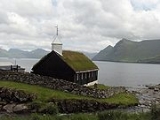
Funningur Church
Encyclopedia

Funningur
Funningur is a town on the Faroe Islands. It is located on the north-west coast of Eysturoy . It was the only village in the municipality called Funnings kommuna, which on 1 January 2009 became part of Runavíkar kommuna....
, is one of the 10 old wooden churches in the Faroe Islands
Faroe Islands
The Faroe Islands are an island group situated between the Norwegian Sea and the North Atlantic Ocean, approximately halfway between Scotland and Iceland. The Faroe Islands are a self-governing territory within the Kingdom of Denmark, along with Denmark proper and Greenland...
. It was inaugurated on 30 November 1847 and is for that reason the newest of the old traditional wooden churches. Porkeri Church
Porkeri Church
Porkeri Church is a church in the settlement of Porkeri in the Faroe Islands. Porkeri is situated in the island Suðuroy, which is the southernmost of the islands. The church of Porkeri was built in 1847...
was also inaugurated in 1847 but a few months beforehand.
Funningur Church is the only wooden church and the oldest church in the Eiði
Eiði
Eiði is a large village located on the north-west tip of Eysturoy, Faroe Islands Its name means isthmus in the Faroese language. The town has a population of 669In the center of the village there is a large stone church from 1881...
parish. Until 1929, when the Gjógv
Gjógv
Gjógv |geo]]) is a village located on the northeast tip of the island of Eysturoy, in the Faroe Islands and 63 km north by road from the capital of Tórshavn...
Church was inaugurated, it was the parish church for both the villages of Funningur and Gjógv.
The spot where the church stands is called Niðri í Hólma ("down on the islet"). Nowadays the area is no longer like an islet, as the River Stórá runs from the north of the church and flows below it. The river also separates the church from the new cemetery, which was inaugurated in 1941 and expanded in 1972.
The church has 10 pews on the men's side and 9 on the women's side. The pulpit is in front of the foremost of the women's pews.

